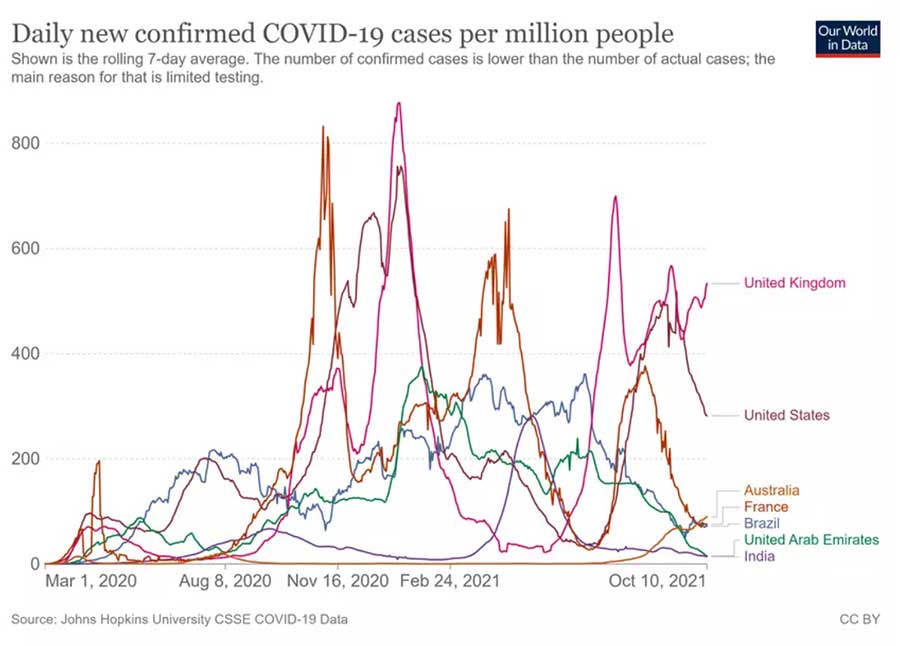Is it a cold or COVID-19? An expert explains
Research in the UK shows COVID-19 symptoms can be similar to the common cold. So, how can you tell the difference? Here, genetic epidemiologist Professor Tim Spector explains the latest data and what you need to know.
- 19 October 2021
- 4 min read
- by World Economic Forum

In February this year, as the UK was still under tight COVID-19 restrictions, cases of seasonal flu dropped to zero.
Now the country, like much of the northern hemisphere, is entering the cold and flu season with few to no COVID-19 restrictions in place – and seasonal respiratory illnesses are making a comeback.
In the week to 3 October, calls to the UK's National Health Service and GP consultations for upper and lower respiratory tract infections rose more than normal, a phenomenon that was also seen in Hong Kong in October last year, once schools and nurseries reopened.
This could be because people are no longer required to wear masks and social distance, their immune systems are also not used to the viruses – and it could put additional strain on health systems, warn doctors.
Professor Peter Openshaw, at Imperial College London, told the Guardian: “[Common colds] are bouncing back and the respiratory tract has not had enough recent experience of respiratory infections to be able to mount that strong first line defence".
However, COVID-19 cases are also rising in the UK - and as COVID-19 is more deadly than colds and flu, it's important to get tested to make sure, says an expert.

Image: Our World in Data
How to tell if it's a cold or COVID-19
Professor Tim Spector is a professor of genetic epidemiology at King's College London and leads the UK's ZOE COVID Symptom Study, which has been running since March 2020 and has 4 million daily contributors.
He says the research shows there are no longer just three main symptoms of COVID-19 (cough, fever, and loss or change of smell) – and there's increasing crossover between cold and COVID symptoms, particularly among those who have been vaccinated.
Have you read?
"Nearly 50% of people currently having a positive PCR test do not have the classical symptoms whilst they're infectious," he says in a YouTube video update. "Every day they deliberate, more people are getting infected."
Since March 2021, the ZOE study has reported 21 symptoms of COVID-19 to look out for, including sneezing, sore throat, hoarse voice and a runny nose, which are more traditionally associated with the common cold.
Runny nose? Sore throat? Headache? With symptoms between COVID and colds so similar, how do you know which one you have, and if you should isolate? We've written a blog to help you understand https://t.co/8LKAZC2fL9
— join_zoe (@Join_ZOE) September 21, 2021
ZOE says: "Our data shows that loss of smell (anosmia) or loss of taste is still one of the most important predictors of testing positive for COVID-19 rather than a regular cold, so it’s an important symptom to look out for, whether you’ve been vaccinated or not."
Sniffing scented foods at home, or noticing whether familiar foods start to lose their flavour or taste strange, is a good way to check.
Symptoms different among vaccinated
There's a gap appearing between symptoms of COVID-19 among people who have been vaccinated - and those who haven't.
The most common symptoms of COVID-19 among those who have been vaccinated are currently runny nose, headache, sneezing, sore throat and loss of smell. While for those who are unvaccinated, it's headache, runny nose, sore throat, fever and persistent cough.
Professor Spector says: "There are thousands of cases every day that are actually COVID that people thought were just a cold and they're spreading it to other people. And that's one reason why we have such high rates compared to other countries, where there is public awareness of what's going on."
He encourages everyone with "cold or flu-like symptoms" to take a lateral flow test followed by a PCR test to confirm it's not COVID-19.
"It's a lot easier to work from home for a couple of days if you're feeling under the weather, without spreading it around, and get yourself a test.
"We need to find the sweet spot between over-obsessing about the virus and too much complacency, which I think there is at the moment.
"If you do have a cold, think, 'It could be COVID', and keep your distance until you know whether it is or not."
Watch Professor Spector explain how to tell if it's a cold or COVID-19 here:
Author
Kate Whiting
Senior Writer, Formative Content
Website
This article was originally published by the World Economic Forum on 14 October 2021.









